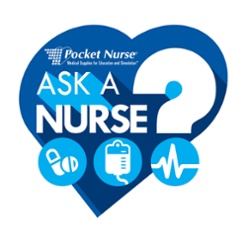
Pocket Nurse founder and CEO Anthony Battaglia, RN, MSN, BSN, has been involved with nursing education and healthcare simulation since 1992. Having nurse educators on the team to familiarize Sales, Customer Service, and Marketing department employees has always been important to him. Current corporate nurse educators are Fabien Pampaloni, MSN, RN and Beth Telesz MSN, RN.
Recently, Dawn Mangine, content manager, sat down for a conversation with Anthony, Fabien, and Beth ahead of Healthcare Simulation Week, which is sponsored and promoted every year by Society for Simulation in Healthcare (SSH). Here are their thoughts about the current state and future of simulation in healthcare education. (Hint: It’s really good.)
What recent technologies are revolutionizing the world of simulation?
The biggest thing now is virtual reality. VR has really taken hold, not only stand-alone virtual reality systems, but also manikin simulators, which incorporate VR into the manikins.
Technology in general is also getting better and being used more. Video and audio technology is improving in simulation centers. Instructors have a variety of modalities they can employ.
Where do you see simulation headed in the near future?
Simulation is in its pre-adolescence stage, and there is a lot of potential for growth and opportunity. Clinical space is limited, plus simulation can more directly address specialties such as pediatrics and OB. In addition, we are seeing the growth of continuing education. Anthony says, “The majority of our customers are colleges and universities, but don’t forget simulation for continuing education is also growing. In the hospital sector, they are building simulation centers for the education of their own staff.”
Students are missing fewer opportunities because of the access to simulation in education. “Simulation is the way we are educating people when there is a real-life experience missing in the clinical setting,” adds Beth.
Are you concerned or excited by the increasing rate institutions are adopting simulation?
We are excited because if simulation weren’t being adopted, if we didn’t have the nursing studies that support the integration of simulation into education, we’d be going backward. It’s exciting to be in this industry and it’s exciting to see the growth that is still possible.
Patients are going to recognize and expect safer healthcare because of the simulation education that is happening with students now.
"Simulation is fiction. Your decisions are real."
Although the field is exciting, one concern to acknowledge is expanding legislation and regulations. “I wonder as simulation is adopted, how organizations will standardize education,” says Fabien. “Will everybody follow standards of good practice?”
Anthony believes states will regulate simulation education, just as how many states have guidelines around hours of simulation versus hours of clinical education. In addition, professional organizations like SSH and INACSL have created standards, definitions, and terms that educational organizations are going to be eager to adopt.
What do you believe triggered the somewhat urgent need for simulation we have witnessed in recent years?
Again, the lack of clinical space, the need for patient safety, and the need for better healthcare practices have spurred the growth in simulation. Especially in areas like pediatrics and obstetrics, where clinical opportunities are not easily accessible. As the needs in specialties grow, simulation is able to fill those spots.
Another thing we have seen cited often as simulation in healthcare education has grown and been studied is the Institutes of Medicine report To Err is Human. While simulation has been used for a long time in anesthesiology, and in CPR and skills labs, the movement of simulation being a basic expectation kicked off with that report, which came out in 1999.
Competition between healthcare education programs is a factor too. “If I were a nursing student today,” Beth says, “I’d be looking for the college that had the best simulation center.” Accrediting organizations are having an impact as well.
Anthony adds, “As we say, ‘Simulation is fiction; your decisions are real.’”

Has the medical industry been receptive to helping simulation grow?
Absolutely. Pocket Nurse has been supported by manufacturers of medical equipment who have encouraged us to distribute products to schools and educational organizations.
Do you consider yourself a simulation pioneer?
Anthony says, “I’ve grown up with simulation, and created a business that revolves around supporting it.” We distribute exclusively to educational institutions and organizations, from high school-level CTE programs, EMS training programs, and pharmacy and nursing schools.
Is simulation for everybody?
From a healthcare education perspective, it certainly is. But it’s important that organizations find the proper resources, tools, and equipment to fulfill their learning objectives. Simulation is a big part of that, but simulation curriculum isn’t just about being around a manikin for hands-on learning. If you’re an educator, you use a variety of strategies to meet learning objectives.
What are the challenges of simulation?
The biggest challenge comes in making the simulation scenarios on one hand immersive and complete, and on the other hand making them psychologically safe for students. Another big challenge for schools is having enough faculty and staff to teach simulation. The number of instructors who are knowledgeable about the simulation technology is not as big as the institutions would like to see. Fabien says, “Feedback from our customers tells us that finding and retaining faculty to run a simulation center is a huge issue.”
Beth adds, “Fear of the technology can limit an excellent instructor from using the equipment available to them.” Turnover, teaching new faculty, and finding funding are other challenges that programs face.
What are your thoughts about simulation substituting real clinical time?
We have to keep in mind that there is no substitution for human touch. However, we absolutely support substituting simulation hours for clinical hours to a certain extent. Presently, substituting simulation for clinical is regulated by each state’s board of nursing. Experience with real patients will remain vital to healthcare education. Simulation is definitely a best alternative for some procedures that are rarely done, or impossible to schedule (i.e. childbirth). Simulation scenarios are also important for students to learn how to use equipment and administer medications. Ultimately, simulation will continue to work with clinical time rather than replacing it completely.
Pocket Nurse is known to many for disposable products and Demo Dose® simulated medications for education. What else does Pocket Nurse offer to educators who are just starting out with simulation or to those that wish to take their simulation programs to the next level?
Pocket Nurse offers complete lines of simulation equipment and medical education tools and resources. We have over 6,000 simulation solutions to meet customer needs. Our portfolio includes vital sign equipment, SimVS monitors, a simulated glucometer, task trainers, wearable tech and much more, such as:
- Furniture for a complete simulated hospital room
- Headwalls with customizable options
- Simulators/Manikins for hands-on learning
- Automatic Dispensing Carts/Cabinets (ADCs) to teach medication management
- Casework for retail simulation, storage, and office space
Plus, our sales and customer service teams are knowledgeable in creating a complete simulation education laboratory or classroom.
 As a nurse owned and operated company, Pocket Nurse think the service Ask-a-Nurse is important for simulation educators. Ask-a-Nurse is a free program provided by the nurse experts here, namely Anthony, Beth, and Fabien. Our objective is to provide answers to simulation-related questions and offer direction to our valued customers.
As a nurse owned and operated company, Pocket Nurse think the service Ask-a-Nurse is important for simulation educators. Ask-a-Nurse is a free program provided by the nurse experts here, namely Anthony, Beth, and Fabien. Our objective is to provide answers to simulation-related questions and offer direction to our valued customers.






